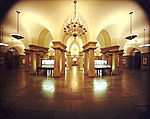1983 United States Senate bombing
1983 crimes in the United States1983 in Washington, D.C.98th United States CongressAttacks on buildings and structures in the United StatesAttacks on the United States Congress ... and 9 more
Building bombings in the United StatesCommunist terrorismCrimes in Washington, D.C.Explosions in 1983November 1983 events in the United StatesTerrorist incidents in the United States in 1983United States CapitolUse mdy dates from July 2021Weather Underground

The 1983 U.S. Senate bombing was a bomb explosion at the United States Senate on November 7, 1983, as a protest against United States military involvement in Lebanon and Grenada. The attack led to heightened security in the DC metropolitan area, and the inaccessibility of certain parts of the Senate Building. Six members of the radical far-left Armed Resistance Unit (also known as Resistance Conspiracy) were arrested in May 1988 and charged with the bombing, as well as related bombings of Fort McNair and the Washington Navy Yard which occurred on April 25, 1983, and April 20, 1984, respectively.
Excerpt from the Wikipedia article 1983 United States Senate bombing (License: CC BY-SA 3.0, Authors, Images).1983 United States Senate bombing
West Terraces and Steps, Washington
Geographical coordinates (GPS) Address Phone number Website Nearby Places Show on map
Geographical coordinates (GPS)
| Latitude | Longitude |
|---|---|
| N 38.89 ° | E -77.009 ° |
Address
United States Capitol
West Terraces and Steps
20534 Washington
District of Columbia, United States
Open on Google Maps







